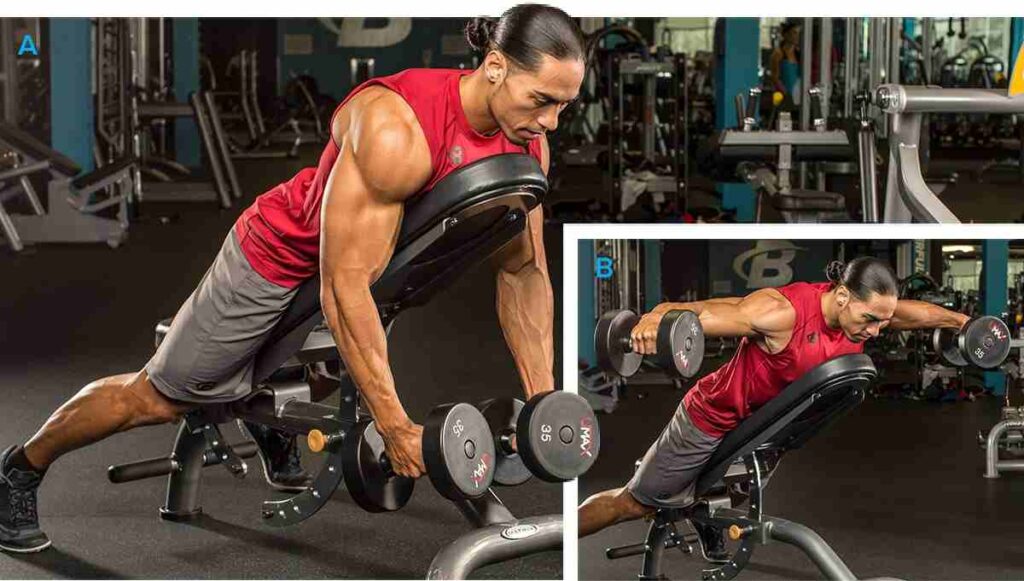Introduction
Welcome to the world of fitness, where sculpting your dream physique is not just a goal but a journey. If you’ve found your way to this article, you’re likely on a quest to enhance your shoulder strength, stability, and aesthetics. You’re in the right place!
This comprehensive guide will delve into the exercise that can be a game-changer in your fitness routine: the one arm lateral cable raise. Whether you’re a beginner taking your first steps into the gym or a seasoned fitness enthusiast looking to diversify your shoulder workouts, this exercise has something to offer everyone.
Why Should You Care About the One Arm Lateral Cable Raise?
Shoulders play a crucial role in your overall upper body strength and appearance. A well-defined set of shoulders not only looks impressive but also contributes to better posture and reduces the risk of injury in daily activities.
SHOP FOR THE CABLE MACHINE ATTACHMENTS ON AMAZON
This guide will take you through the nuances of this exercise, from understanding its mechanics to perfecting your form, and incorporating it into a well-rounded workout routine. By the time you finish reading, you’ll have the knowledge and confidence to perform the one arm lateral cable raise with precision, ensuring maximum benefits and minimal risk of injury.
Understanding the One Arm Lateral Cable Raise
The one arm lateral cable raise, also known as the single-arm cable lateral raise, is a resistance exercise designed to isolate and strengthen the lateral deltoid muscle, which is the muscle responsible for the rounded, “capped” appearance of your shoulders. This exercise involves using a cable machine with a single handle attachment to create resistance while you lift your arm out to the side.
Targeted Muscles and Benefits
The one-arm cable lateral raise is an isolation exercise that targets the lateral deltoid, which is the middle portion of the deltoid muscle. It also works the anterior deltoid, posterior deltoid, upper trapezius, and serratus anterior muscles.
- Lateral deltoid is the muscle that gives your shoulders their rounded shape. It is responsible for raising your arms out to the sides.
- Anterior deltoid is the muscle that is responsible for raising your arms in front of your body.
- Posterior deltoid is the muscle that is responsible for pulling your arms back behind your body.
- Upper trapezius is the muscle that is responsible for raising your shoulders and shrugging your shoulders.
- Serratus anterior is the muscle responsible for pulling your shoulder blades forward.
SHOP FOR THE ADJUSTABLE DUMBBELLS ON AMAZON
The one-arm cable lateral raise can be done with a variety of weights and repetitions, depending on your fitness level. It is important to keep your core engaged and your back straight throughout the exercise to avoid injury.
Equipment Needed
Performing the one arm lateral cable raise requires specific equipment to ensure proper form and effectiveness:
- Cable Machine: You will need access to a cable machine, which can usually be found in most gyms. It consists of a pulley system with adjustable weights.
- Single Handle Attachment: Attach a single handle to the low pulley of the cable machine. This handle will be used to perform the exercise.
This exercise can be done as part of a shoulder workout or as a standalone exercise. It is a good way to isolate the medial deltoid and build a well-rounded set of shoulders.
Proper Form and Technique
The one arm cable lateral raise is a great exercise for isolating and targeting the middle deltoids, the muscles on the sides of your shoulders. It can be done with a cable machine or a resistance band.
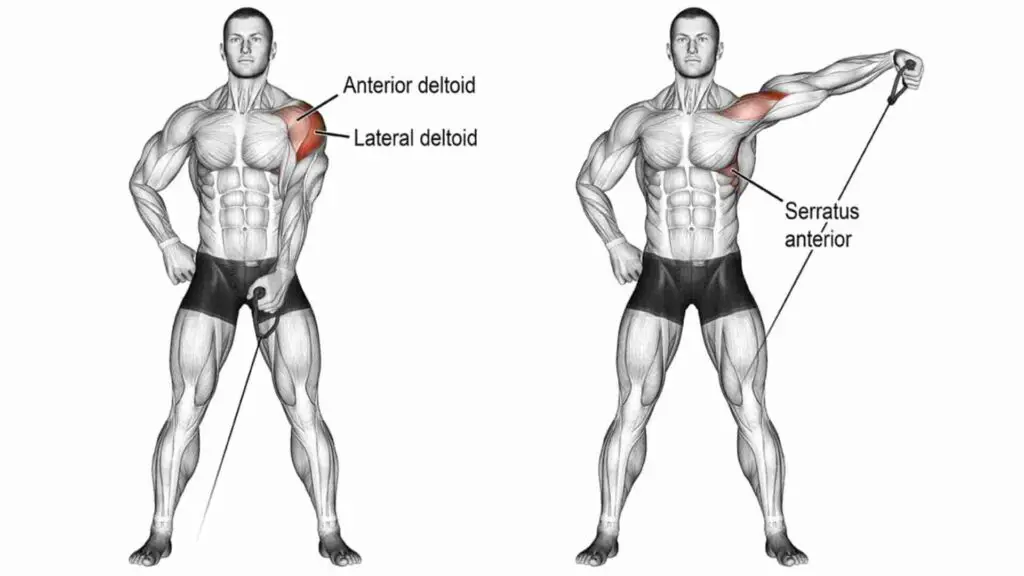
To do a one arm cable lateral raise, follow these steps:
- Stand facing away from the cable machine with your feet shoulder-width apart.
- Grab the cable handle with your right hand (or the hand farthest from the machine) using a neutral grip (palms facing down).
- Keep your elbow slightly bent and your arm close to your side.
- Exhale as you raise your arm up and out to the side, until it is parallel to the floor.
- Pause for a second at the top, then slowly lower your arm back to the starting position.
- Repeat for the desired number of repetitions, then switch sides.
Here are some tips for proper form:
- Keep your core engaged throughout the exercise.
- Don’t let your arm swing or wobble.
- Don’t raise your arm too high, as this can put strain on your shoulders.
- If you feel pain, stop the exercise and consult with a doctor or physical therapist.
Here are some common mistakes to avoid:
- Using too much weight.
- Not engaging your core.
- Swinging your arm.
- Raising your arm too high.
- Locking out your elbow at the top of the movement.
SHOP FOR THE BEST QUALITY SUPPLEMENTS ON AMAZON
The one arm cable lateral raise is a challenging exercise, but it is also a very effective one for building strong and defined shoulders. By following the proper form and technique, you can minimize the risk of injury and get the most out of this exercise.
Benefits of One Arm Lateral Cable Raise
The One Arm Lateral Cable Raise is an effective exercise that primarily targets the lateral deltoid muscle of the shoulder. Here are the key benefits of incorporating this exercise into your fitness routine:
- Isolation of the Lateral Deltoid: The primary benefit of the One Arm Lateral Cable Raise is its ability to isolate and target the lateral deltoid, which is responsible for the broadening of your shoulder. This exercise helps to build strong, defined shoulder muscles.
- Improved Shoulder Aesthetics: By strengthening the lateral deltoid, this exercise contributes to a balanced and well-defined shoulder appearance. It can enhance the V-taper look, making your upper body appear more aesthetically pleasing.
- Enhanced Shoulder Functionality: Strong lateral deltoids are essential for overall shoulder stability and functionality. This exercise helps improve your shoulder’s ability to perform various daily tasks and sports movements involving lifting or reaching.
- Injury Prevention: Strengthening the lateral deltoid can reduce the risk of shoulder injuries, especially during activities that involve overhead movements. A strong deltoid can provide better support and stability to the shoulder joint.
- Rehabilitation: The One Arm Lateral Cable Raise is often recommended by physical therapists as a part of shoulder rehabilitation programs. It can help individuals recover from shoulder injuries or surgery by gradually strengthening the muscles around the joint.
- Muscle Imbalance Correction: Many individuals have an imbalance between their front and rear deltoids compared to their lateral deltoids. This exercise can help correct this imbalance, promoting overall shoulder health.
- Functional Strength: Strengthening the lateral deltoid can have functional benefits beyond aesthetics. It can improve your performance in activities like lifting objects, carrying groceries, and playing sports that involve throwing or pushing motions.
SHOP FOR THE WORKOUT MAT ON AMAZON
In summary, the One Arm Lateral Cable Raise is a versatile and effective exercise that offers numerous benefits, including improved shoulder aesthetics, functionality, injury prevention, and muscle balance correction. It’s a valuable addition to any well-rounded fitness routine, especially for those looking to build strong, well-defined shoulders.
Variations of the One Arm Lateral Cable Raise
Here are some variations of the one arm cable lateral raise:
Leaning cable lateral raise: This variation helps to isolate the medial deltoids by taking out some of the assistance from the traps and upper back. To do this exercise, stand sideways to the cable machine and lean forward slightly at the waist. Grab the cable handle with a neutral grip and raise your arm up to shoulder level, keeping your elbow slightly bent. Slowly lower the weight back to the starting position.
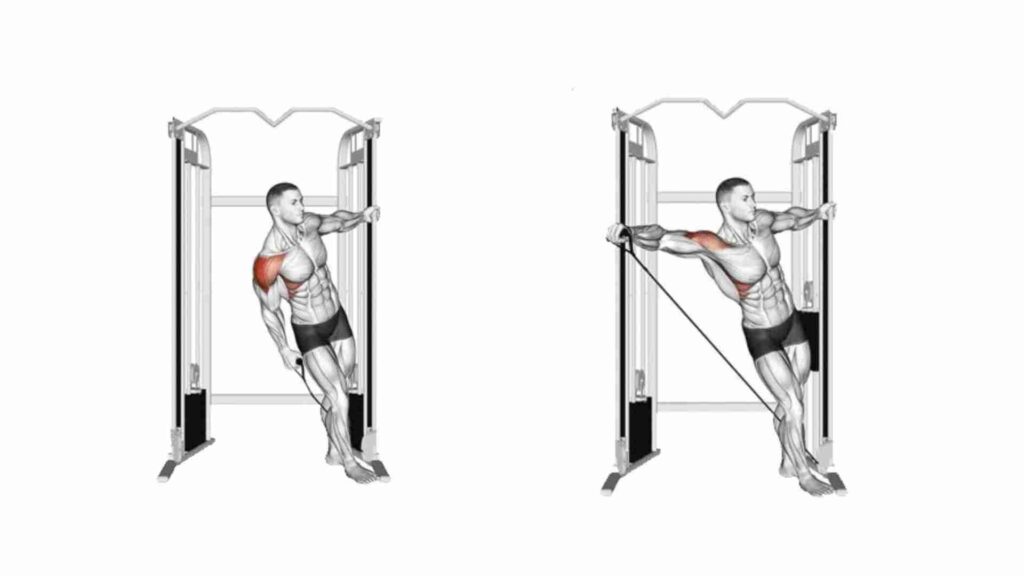
Side-lying cable lateral raise: This variation is similar to the leaning cable lateral raise, but you lie on your side on a bench with your feet flat on the floor. This helps to further isolate the medial deltoids and also works the core muscles. To do this exercise, grab the cable handle with a neutral grip and raise your arm up to shoulder level, keeping your elbow slightly bent. Slowly lower the weight back to the starting position.
Dumbbell lateral raise: This variation uses dumbbells instead of a cable machine. It is a good option if you do not have access to a cable machine or if you want to challenge yourself with a heavier weight. To do this exercise, stand with your feet shoulder-width apart and hold a dumbbell in each hand at your sides. Raise your arms up to shoulder level, keeping your elbows slightly bent. Slowly lower the weights back to the starting position.
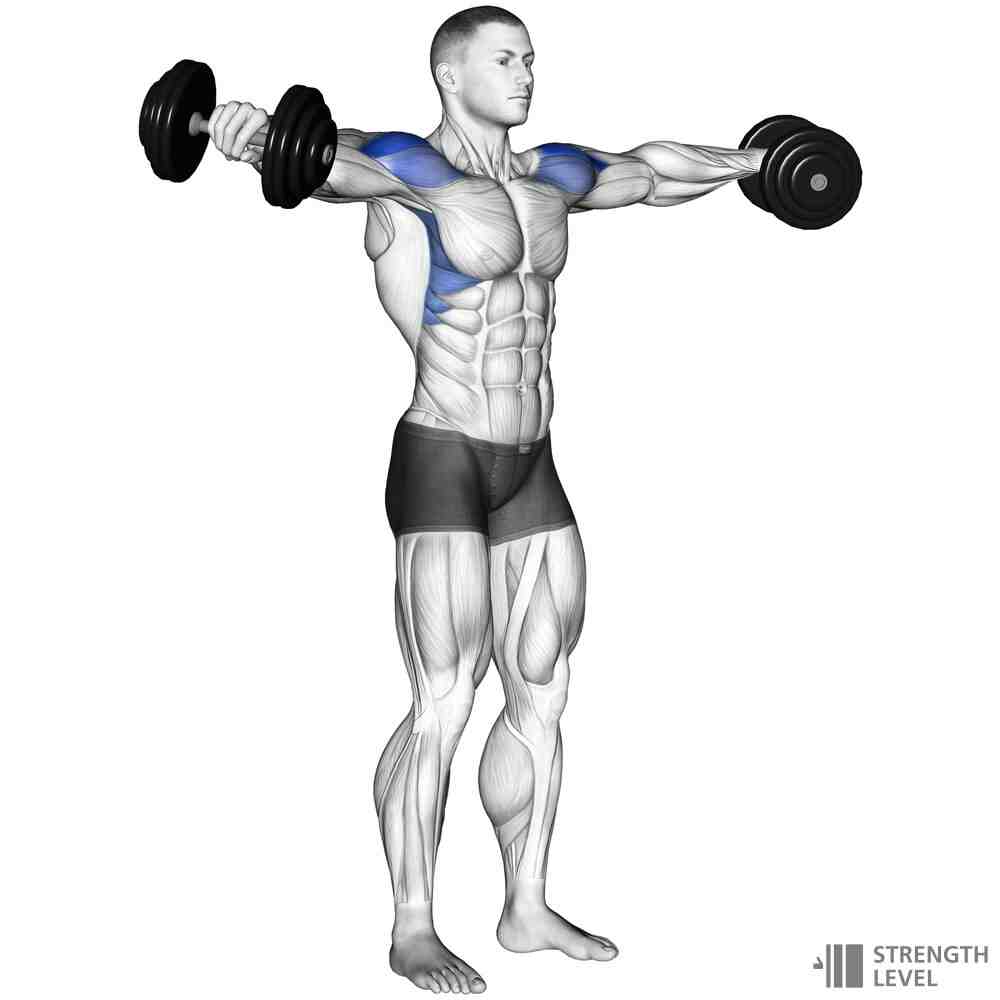
Barbell overhead press: This compound exercise works the shoulders, triceps, and upper back. To do this exercise, stand with your feet shoulder-width apart and hold a barbell in front of your chest with an overhand grip. Press the barbell overhead until your arms are straight. Slowly lower the barbell back to the starting position.
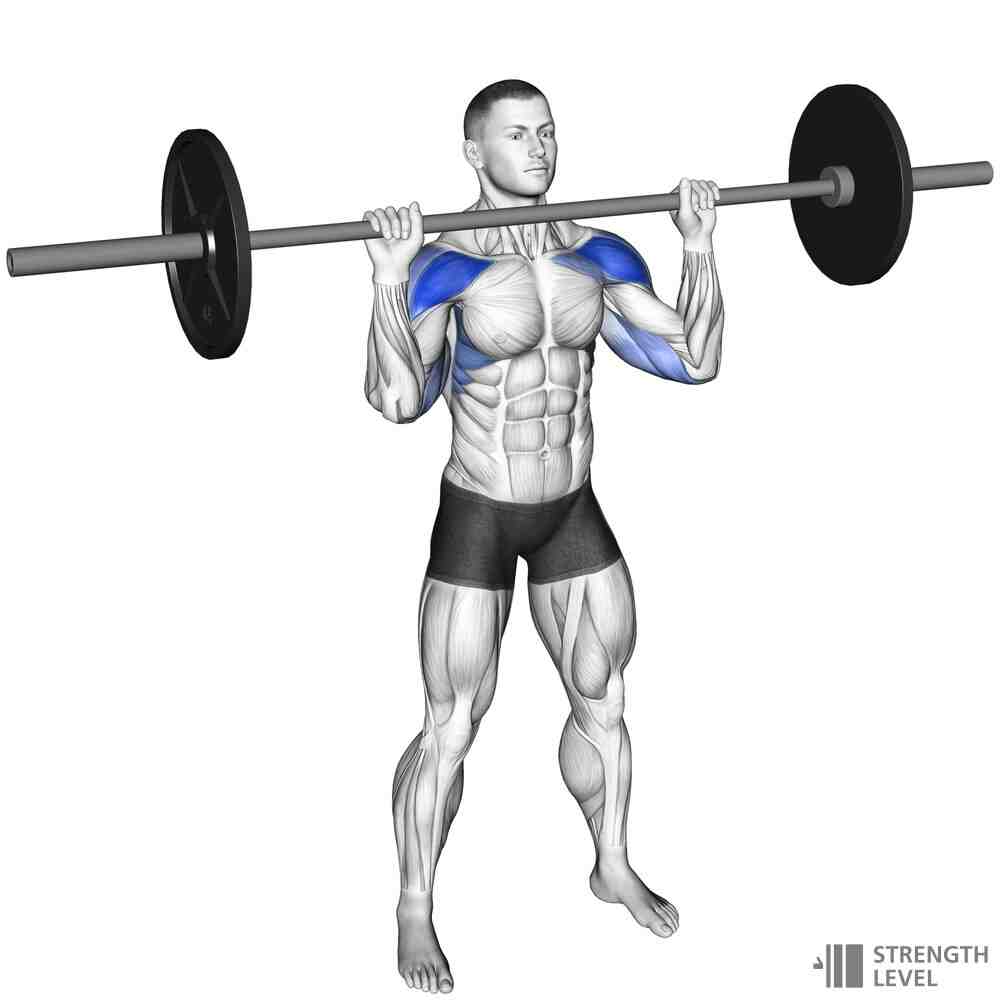
If you are new to weight training, it is a good idea to start with a light weight and gradually increase the weight as you get stronger. You should also consult with a qualified personal trainer to make sure you are using the proper form.
Nutrition and Recovery
Proper nutrition and recovery are essential aspects of any effective fitness routine, including those that involve the one arm lateral cable raise. Here, we’ll explore the importance of maintaining a balanced diet and incorporating recovery strategies to maximize the benefits of this exercise.
Nutrition: Fueling Your Progress
- Protein Intake: Protein is the building block of muscles, and ensuring an adequate intake is crucial for muscle repair and growth. Incorporate lean sources of protein like chicken, turkey, fish, and plant-based options like tofu and legumes into your diet.
- Carbohydrates: Carbohydrates provide the energy needed for intense workouts. Opt for complex carbohydrates like whole grains, fruits, and vegetables to sustain your energy levels during training sessions.
- Healthy Fats: Essential fatty acids are vital for overall health and help support joint function. Include sources of healthy fats like avocados, nuts, and olive oil in your diet.
- Hydration: Staying hydrated is often overlooked but is critical for muscle function and recovery. Aim to drink plenty of water throughout the day, and consider electrolyte-rich beverages if you’re engaged in intense workouts.
- Supplements: Some individuals may benefit from supplements like creatine or branched-chain amino acids (BCAAs) to support muscle recovery. Consult with a healthcare professional or a nutritionist before adding supplements to your routine.
Recovery: Healing and Growth
- Rest: Adequate rest is essential for recovery. Ensure you get enough sleep each night to allow your body to repair and grow. Aim for 7-9 hours of quality sleep.
- Active Recovery: Engage in light physical activity or mobility exercises on your rest days to promote blood flow and alleviate muscle soreness.
- Stretching and Flexibility: Incorporate stretching exercises into your routine to maintain flexibility and prevent muscle tightness. Yoga or dedicated stretching sessions can be beneficial.
- Massage and Foam Rolling: These techniques can help reduce muscle tension and improve circulation, aiding in recovery. Consider regular massages or using a foam roller to target specific areas.
- Nutrient Timing: Consume a post-workout meal or snack that includes protein and carbohydrates within an hour of completing your workout. This can enhance muscle recovery and replenish glycogen stores.
- Listen to Your Body: Pay attention to any signs of overtraining or excessive fatigue. It’s okay to adjust your training intensity or take extra rest days when needed.
SHOP FOR THE FITNESS TRACKER ON AMAZON
Incorporating these nutrition and recovery strategies into your fitness routine alongside the one arm lateral cable raise will not only enhance your performance but also reduce the risk of injury.
FAQs
Q 1. How does the one arm lateral cable raise compare to lateral raises with dumbbells?
Ans. While both exercises work the lateral deltoids, the cable raise provides constant tension throughout the movement due to the resistance from the cable. This can be beneficial for muscle growth and control. Dumbbell lateral raises, on the other hand, rely on gravity, which means the tension varies during the exercise.
Q 2. Can beginners safely perform the one arm lateral cable raise?
Ans. Yes, beginners can perform this exercise, but it’s important to start with a lighter weight to master proper form and prevent injury. Gradually increase the weight as your strength and control improve.
Q 3. Is there a risk of injury if I perform the one arm lateral cable raise with improper form?
Ans. Yes, improper form can increase the risk of injury, especially to the shoulder joint. Common mistakes include using excessive weight, swinging the arm, and arching the back. It’s crucial to maintain strict form and control throughout the movement.
Q 4. How heavy should the cable weight be for the one arm lateral cable raise?
Ans. The appropriate weight varies from person to person. Start with a weight that allows you to perform 10-12 repetitions with good form. As you become more experienced, gradually increase the weight while maintaining proper technique.
Q 5. Can I incorporate the one arm lateral cable raise into my routine even if I have a history of shoulder injuries?
Ans. It’s important to consult with a healthcare professional or physical therapist if you have a history of shoulder injuries before adding this exercise to your routine. They can provide guidance on whether it’s safe for you and offer modifications if needed.
Q 6. How often should I include the one arm lateral cable raise in my workout routine?
Ans. The frequency depends on your overall workout program, but generally, you can include it 2-3 times per week as part of your shoulder or upper body training. Ensure you allow adequate rest between sessions to promote recovery.
Conclusion
In conclusion, mastering the one arm lateral cable raise can be a game-changer in your fitness journey. This exercise, targeting the lateral deltoid, offers a multitude of benefits, including improved shoulder strength, stability, and injury prevention.
By understanding the correct form and technique, incorporating it into your workout routine, and following safety guidelines, you can reap the rewards of this effective exercise. Whether you’re a beginner or an experienced gym-goer, the one arm lateral cable raise can be tailored to your fitness level.
Remember, consistency is key, so track your progress, prioritize proper nutrition and recovery, and stay committed to your fitness goals.

Good day, and welcome to Fitthour. My name is Shubham Vijay, and I am a certified personal trainer and nutrition coach with 6 years of experience in the fitness industry. At Fitthour, we specialize in types of training, such as strength training, cardio, or HIIT, and our mission is to help clients achieve their fitness goals and improve their overall health.



